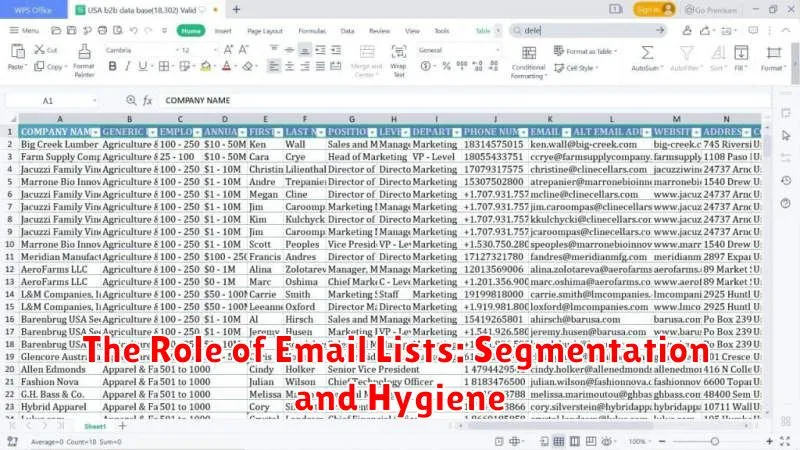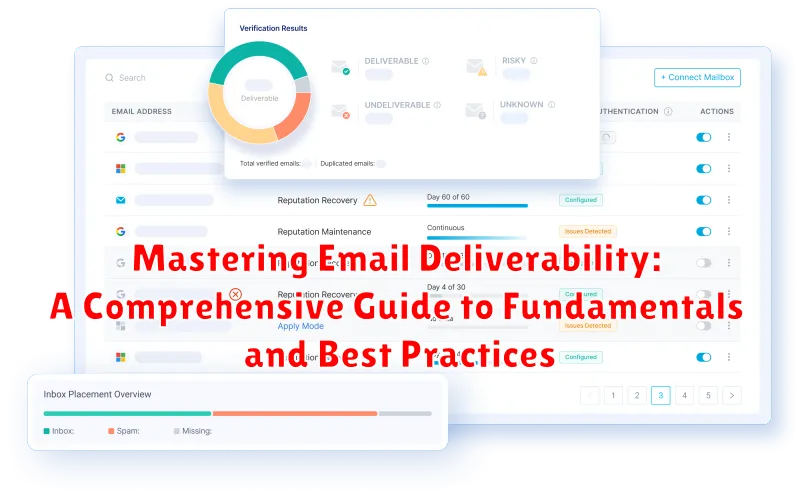Are you struggling to ensure your emails reach the intended inbox? In today’s digital landscape, effective email deliverability is paramount for successful marketing campaigns, crucial business communications, and maintaining a strong sender reputation. This comprehensive guide, “Mastering Email Deliverability: A Comprehensive Guide to Fundamentals and Best Practices,” delves into the core principles and strategies necessary to navigate the complexities of email marketing and achieve optimal email delivery rates. We’ll explore common pitfalls that lead to emails landing in spam folders and provide actionable insights to prevent these issues.
This guide offers a deep dive into the critical factors influencing email deliverability across various global Internet Service Providers (ISPs) and email providers. We will cover fundamental aspects such as authentication protocols (SPF, DKIM, DMARC), managing bounce rates, understanding spam filters, and segmenting your email lists effectively. Furthermore, we’ll explore best practices for crafting compelling email content, optimizing subject lines, and building a positive sender reputation. Whether you’re a seasoned email marketer or just starting, this guide provides the knowledge and tools you need to master email deliverability and maximize the impact of your email communications.
Understanding Email Deliverability: What It Is and Why It Matters
Email deliverability refers to the ability of your emails to reach your intended recipients’ inboxes. It’s not simply about whether an email is sent, but rather if it successfully avoids spam filters and lands where it’s meant to be seen. Understanding deliverability is crucial for any business relying on email marketing or communication.
Why does it matter? Poor deliverability directly impacts your return on investment (ROI). Emails ending up in spam folders are essentially wasted effort, time, and resources. This leads to:
- Reduced engagement: Fewer people see your message, resulting in lower click-through rates and conversions.
- Damaged sender reputation: Repeatedly sending emails that are marked as spam harms your sender reputation, making it even harder to reach inboxes in the future.
- Lost revenue: Missed opportunities to connect with customers and drive sales.
In essence, good email deliverability ensures that your message is heard, allowing you to build relationships, nurture leads, and ultimately achieve your business goals. Ignoring deliverability is akin to throwing marketing dollars away.
Key Factors Influencing Email Deliverability: Reputation, Authentication, and Content
Email deliverability hinges on three crucial factors: reputation, authentication, and content. These elements work synergistically to determine whether your emails reach the intended recipients’ inboxes or are diverted to spam folders.
Sender Reputation: Your sending reputation is akin to a credit score for email. Internet Service Providers (ISPs) and email providers assess your reputation based on various signals, including bounce rates, spam complaints, and engagement metrics. A positive reputation significantly increases the likelihood of successful email delivery.
Email Authentication: Authentication protocols, such as SPF (Sender Policy Framework), DKIM (DomainKeys Identified Mail), and DMARC (Domain-based Message Authentication, Reporting & Conformance), verify the authenticity of your emails. Implementing these protocols helps ISPs confirm that your messages are genuinely sent from your domain, mitigating the risk of phishing and spoofing attacks. Correct setup builds trust and improves deliverability.
Email Content: The content of your emails plays a vital role in deliverability. Avoid using spam trigger words, excessive capitalization, or misleading subject lines. Ensure your emails are well-formatted, visually appealing, and provide valuable content to your subscribers. A positive user experience encourages engagement and reduces the likelihood of spam complaints.
Setting Up Email Authentication: SPF, DKIM, and DMARC Explained
Email authentication is critical for ensuring that your emails reach your intended recipients’ inboxes. Implementing SPF (Sender Policy Framework), DKIM (DomainKeys Identified Mail), and DMARC (Domain-based Message Authentication, Reporting & Conformance) is essential for verifying the authenticity of your email messages and preventing spoofing.
SPF (Sender Policy Framework)
SPF specifies which mail servers are authorized to send emails on behalf of your domain. This involves creating an SPF record in your domain’s DNS settings. The SPF record lists the IP addresses or domains that are permitted to send emails from your domain.
DKIM (DomainKeys Identified Mail)
DKIM adds a digital signature to your email messages. This signature verifies that the email was sent from your domain and that the message content has not been altered during transit. DKIM involves generating a public and private key pair. The private key is used to sign your emails, while the public key is published in your domain’s DNS settings.
DMARC (Domain-based Message Authentication, Reporting & Conformance)
DMARC builds upon SPF and DKIM by providing instructions to email receivers on how to handle emails that fail SPF or DKIM authentication. DMARC also enables senders to receive reports about email authentication results, allowing them to identify and address potential issues. Implementing DMARC involves creating a DMARC record in your DNS settings.
Managing Your Sender Reputation: IP Warming and Consistent Sending Practices
Your sender reputation is a crucial factor influencing email deliverability. It’s essentially a score assigned to you by ISPs and email providers based on your sending behavior. A good reputation means your emails are more likely to land in the inbox, while a poor reputation can lead to your emails being filtered as spam.
IP Warming
IP warming is the process of gradually increasing the volume of emails sent from a new IP address. This helps establish a positive sending reputation with ISPs. Avoid sending large volumes of emails immediately. Start small and gradually increase the volume over time.
Consistent Sending Practices
Consistency is key. Maintain a regular sending schedule. Avoid sudden spikes or drops in email volume, as this can trigger spam filters. Regularly clean your email list to remove inactive or invalid addresses. This will help reduce bounce rates and improve your sender reputation.
- Monitor Bounce Rates: Keep hard bounce rates below 2%.
- Maintain Low Complaint Rates: Aim for a complaint rate below 0.1%.
- Authenticate Your Emails: Implement SPF, DKIM, and DMARC.
Crafting Engaging Email Content: Avoiding Spam Filters and Enhancing User Experience
Creating engaging email content is paramount for successful email deliverability and a positive user experience. Avoiding spam filters requires a strategic approach focusing on quality and relevance.
Key considerations include:
- Relevance: Ensure content aligns with subscriber interests and expectations.
- Personalization: Use subscriber data to tailor messaging and offers.
- Clear Value Proposition: Immediately communicate the benefit to the recipient.
- Clean Code: Avoid excessive HTML, large images, and broken links.
- Mobile Optimization: Ensure emails render correctly on various devices.
Avoiding spam triggers is crucial. Refrain from using excessive punctuation, all-caps text, and spammy keywords. A well-structured email with a clear call to action improves user engagement and minimizes the risk of being flagged as spam.
The Role of Email Lists: Segmentation and Hygiene

The effectiveness of your email campaigns hinges significantly on the quality and management of your email lists. Two critical aspects are segmentation and hygiene.
Email List Segmentation
Segmentation involves dividing your subscribers into smaller groups based on shared characteristics. This allows you to send highly targeted and relevant emails, increasing engagement and conversions. Common segmentation criteria include demographics, purchase history, and engagement level.
Email List Hygiene
Email list hygiene refers to the practice of regularly cleaning and maintaining your email list to remove inactive or invalid email addresses. This improves your sender reputation, reduces bounce rates, and optimizes deliverability. Failing to maintain good hygiene can lead to your emails being marked as spam. Regularly remove:
- Bounced addresses
- Unengaged subscribers
- Spam traps
By prioritizing both segmentation and hygiene, you can significantly enhance the performance of your email marketing efforts.
Monitoring Your Email Deliverability: Key Metrics and Tools
Monitoring your email deliverability is crucial for ensuring your messages reach their intended recipients. Several key metrics and tools can help you track and improve your email performance.
Here are some key metrics to monitor:
- Bounce Rate: Percentage of emails that could not be delivered.
- Complaint Rate: Percentage of recipients who mark your email as spam.
- Open Rate: Percentage of recipients who opened your email.
- Click-Through Rate (CTR): Percentage of recipients who clicked on a link in your email.
- Delivery Rate: Percentage of emails successfully delivered to recipients’ inboxes.
Tools for monitoring email deliverability include:
- Sender Score: A reputation score assigned to your sending IP address.
- Postmaster Tools: Provided by major email providers like Gmail and Yahoo, offering insights into your email performance.
- Third-Party Monitoring Services: Platforms that provide comprehensive deliverability monitoring and reporting features.
Troubleshooting Email Deliverability Issues: Common Problems and Solutions
Even with diligent efforts, email deliverability issues can arise. Identifying and addressing these promptly is crucial for maintaining a healthy sending reputation and ensuring your messages reach their intended recipients. Below are some common problems and their potential solutions:
Common Deliverability Problems and Solutions
- High Bounce Rate: Regularly clean your email list by removing invalid or inactive addresses. Implement a double opt-in process to ensure subscribers are genuinely interested.
- Low Engagement Rates: Improve email content relevance and personalize your messages. Segment your audience to target specific interests. A/B test subject lines and calls to action.
- Blacklisting: Identify which blacklists you are on and follow their removal processes meticulously. Analyze your sending practices to identify and rectify the issues that led to the listing.
- Spam Traps: Review your list acquisition methods to ensure compliance. Remove older, unengaged subscribers.
- Authentication Issues: Double-check your SPF, DKIM, and DMARC records to ensure they are correctly configured. Use tools to validate your authentication setup.
Regular monitoring and prompt action are key to resolving deliverability problems efficiently. By addressing these issues, you can improve your sending reputation and ensure your emails reach the inbox.
Staying Compliant with Email Marketing Regulations: GDPR, CCPA, and CAN-SPAM
Navigating the complex landscape of email marketing regulations is crucial for maintaining deliverability and avoiding legal penalties. Key regulations include the General Data Protection Regulation (GDPR), the California Consumer Privacy Act (CCPA), and the CAN-SPAM Act.
GDPR, applicable to EU residents, mandates explicit consent for data collection and processing. It also grants users rights to access, rectify, and erase their data.
CCPA, affecting California residents, provides similar rights, including the right to know what personal information is collected, the right to delete personal information, and the right to opt-out of the sale of personal information.
The CAN-SPAM Act sets rules for commercial email, including requirements for accurate header information, a clear opt-out mechanism, and the inclusion of a physical postal address. Failure to comply with these regulations can lead to substantial fines and damage to your sender reputation. Implement robust data privacy practices and regularly update your compliance measures to align with evolving legal standards.
Future Trends in Email Deliverability: AI and Machine Learning

The landscape of email deliverability is constantly evolving, and Artificial Intelligence (AI) and Machine Learning (ML) are poised to play an increasingly significant role.
AI-Powered Spam Filtering
Expect to see more sophisticated spam filters driven by AI. These filters will analyze email content, sender behavior, and user engagement patterns to identify and block unwanted messages with greater accuracy. This will move beyond simple keyword-based filtering to understanding the nuances of language and context.
Personalized Sending Optimization
AI and ML can optimize send times and frequency based on individual user behavior. By analyzing when recipients are most likely to engage with emails, senders can improve open and click-through rates, thereby enhancing their sender reputation.
Automated Deliverability Monitoring and Remediation
AI can be used to monitor deliverability metrics in real-time and automatically identify potential issues. This includes detecting sudden drops in engagement or increases in bounce rates. Furthermore, AI can suggest remediation strategies, such as adjusting sending volume or updating email authentication settings.

